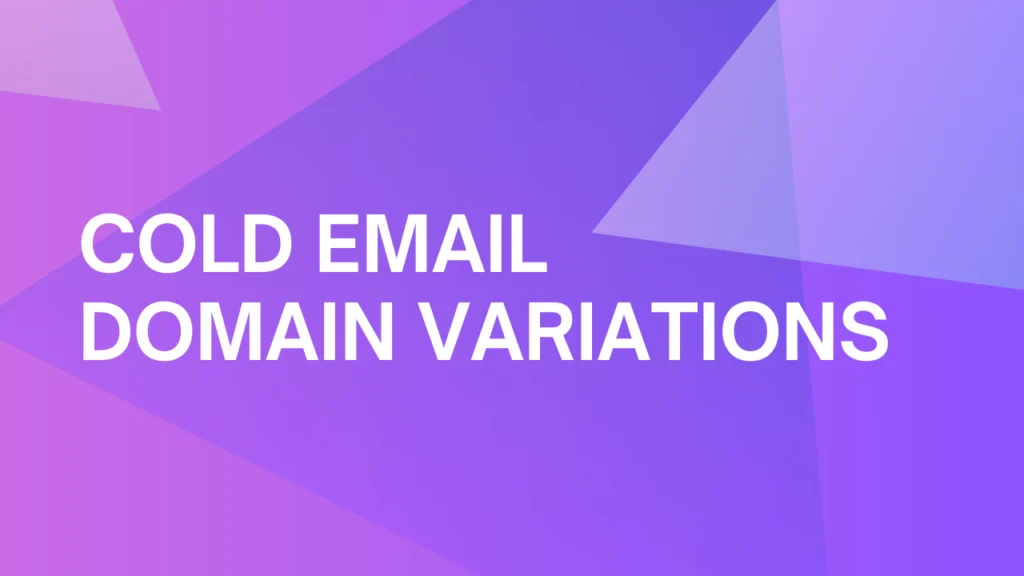
Cold Email Domains: The Guide To Harnessing Deliverability
Sending cold emails can be an excellent way to promote your company’s products, services, and thought leadership content.
However, using the same email domain won’t prove effective when distributing these communications.
Enter cold email domain variations.
Setting up multiple domain variations will level up your marketing initiatives by boosting your email deliverability to better engage your audience and convert more customers.
Get ahead of the curve and gain an edge over your competitors by enhancing your cold email marketing strategy. Additionally, using the best email marketing software can help streamline your campaigns, improve personalization, and increase overall effectiveness
What Is a Cold Email Domain?
Starting with the basics, email domains are the latter half of email addresses; the part following the ‘@’ symbol. Typical email domains you’re probably familiar with include:
- @gmail.com.
- @yahoo.com.
- @outlook.com.
A cold email domain is the email account that your business uses to distribute cold promotional content.
What Are Cold Email Domain Variations?
Cold email domain variations refer to the multiple email domain combinations that you can use when extending your reach to potential clients and customers.
Sending a high volume of unwarranted emails from one professional email address, or continuously using campaigns that don’t generate strong levels of engagement, will increase your chances of experiencing email deliverability issues.
That’s why organizations employ different domain variations as a clever strategy to dodge spam filters, mitigate the risk of getting blacklisted and contact more users.
This method requires creating various domains and subdomains to make the emails appear as though they’re getting sent from separate sources, as opposed to one sales team.
A more common use of cold domain variations involves creating similar subdomains.
You can add phrases like “info”, “contact” or “support” to your primary domain to offer consistency within these combinations.
For example, your company’s standard domain may be “[companyname.com], but you can create an email list of corresponding domains, such as:
- @[company.name].com.
- @[contactcompanyname].com.
- @[companynamesupport].com.
What Does an Email-Sending Schedule Look Like?
When forming an email schedule and planning your cold email sequence, it’s important for cold emailers to start off slow and work their way up.
Sending a high volume of emails off the bat will immediately alert your email service provider (ESP).
Start by sending free emails, and as time goes on, your domain reputation will grow, meaning you can safely increase your sending volume.
In the beginning, your cold sales email outreach might be planned as follows:
- Week 1: 10 emails a day.
- Week 2: 25 emails a day.
- Week 3: 50 emails a day.
- Week 4: 65 emails a day.
Once your main domain is at maturity, make sure to keep note of the daily sending limitations for various providers. Here are some of the main ESP limits:
- Gmail: 500
- Google Workspace: 2,000
- Outlook: 300
- Microsoft 365: 10,000
- Zoho: 1,000
- Yahoo: 500
- Amazon Workmail: 10,000
- AOL: 500
How To Set up a Cold Email Domain
If you’re looking to create various email domains for your company, here are the steps you need to take to get set up.
1. Pick Your New Domain
First, decide on what domain name and top-level domain (TLD) you wish to send emails from and purchase this from your hosting provider. Places you can buy these from include Google Domains and Namecheap.
It’s important to note that some TLDs perform better than others.
When deciding on the TLD you want to use, it’s best to refrain from .co domains as they typically have worse deliverability when compared to .com, .net, and .io domains.
- .com domains: These are reliable, but emails may get quickly flagged as spam by email service providers. If you choose to use .com, ensure you conduct an email warm-up process for a few weeks before beginning your cold outreach initiatives.
- .co domains: As mentioned, if you want a domain that achieves strong email deliverability rates, .co should be avoided where possible.
- .net domains: This type is a great contender as .net is well esteemed, and large-scale bulk email providers use it because of its tangible results.
- .io domains: These domains are more costly, but they’re also a good option for established businesses as spammers typically steer clear of them.
Your TLD shouldn’t particularly affect your cold marketing long-term, so long as you take the necessary steps to warm up your inbox and only send good-quality emails to vetted sales prospects.
2. Select Your Email Service Provider
The next stage is to choose your email provider, which involves conducting research to identify the right fit for your business.
You may base your decision on factors such as budget, demos, and trials, but finding your ESP isn’t an easy decision.
We’ve highlighted the key elements to consider in your search process to help:
- Features: Build a comprehensive list of features you will frequently require and assess the services prospective ESPs can offer.
- User experience: An intuitive format will save your team from unnecessary hassle. Make sure your provider’s software is straightforward and user-friendly.
- Prices: Avoid aiming for the lowest price on the market. Cost efficiency is key, so take your time to evaluate the best price-to-value ratio.
- Security: It’s important to go with a provider that’s completely committed to data protection as security breaches will directly and significantly impact your business.
- Reviews: Look for testimonials and case studies to better understand how the ESP was helpful for other organizations.
- Privacy: Ensure your provider is compliant with all major legal requirements and protocols, and check their privacy policy to know what to expect.
3. Setting Up Your SPF & DKIM
To heighten your email delivery and ensure they arrive in your prospects’ primary inboxes, you’ll need to set up your SPF and DKIM records.
These are email authentication protocols that ESPs undertake every time you send an email.
If you don’t have these records in place, it’s likely your communications will end up in the spam folder.
Once you purchase your new email domain, it’s best to set up your SPF and DKIM records as soon as possible.
Here’s some guidance on how to set up provided by Microsoft and Google support.
Best Practices for Domain Variations
Cold email domain variations are a powerful tool in your marketing strategy, but only when executed correctly.
We’ve covered the top tips to apply when employing domain variations as part of your cold emailing campaign:
a) Research your target audience
As you would with any marketing approach, thoroughly research your target audience to better understand prospect preferences.
Evaluating this will help you establish stronger domain variations for more responsive campaigns.
Creating names that capture the attention of your audience boosts the likelihood of engagement and customer conversion.
b) Utilise tools to generate domain variations
There are many online tools you can use to quickly generate domain variations.
These intelligent tools streamline and simplify the process by providing multiple suggestions for domain name variations, including different TLDs and subdomains.
c) Keep domain names appropriate and relevant
When using cold email domain variations, refrain from applying domain names that could cause offense or be deemed inappropriate by users.
Instead, stick to variations that have relevance to the company’s name and ensure it sounds professional to support your company’s brand image.
d) Track your cold campaign performance
Measuring your company’s performance should be a part of most of your standard operations.
Likewise, it’s crucial to track and test your cold campaign results to see whether your email outreach efforts are successful.
Marketing tools such as cold email software can help you effectively track your open rate and click-through rate (CTR) performance.
By understanding these metrics, you gain the information you need to make adjustments and enhance your approach.
e) Get your emails warmed up
Now, you know how to set up your new cold email domain, it’s time to focus on your strategy.
If you’ve recently launched your domains, you’ll need to hold the trigger on sending your cold email outreach.
Before you begin distributing high volumes of emails, you should conduct a cold email inbox warm-up for a bare minimum of two weeks to gain the trust of ESPs.
Building a solid sender reputation is key to boosting your email deliverability and securing a place in prospective customers’ primary inboxes.
There are three main areas that contribute to the reputation of a sender:
- Bounce rate
- Spam complaint rate
- Engagement rate
This process involves sending emails to a mass amount of trusted users that engage and respond to your outreach.
The high engagement levels will form positive associations with your various domains, but this can be a very time-consuming and taxing task for businesses to execute alone.
Warmup Inbox will help you to get your domains on the right track.
By syncing your email inbox to our online platform, you’ll become a part of our growing network of real, interactive inboxes.
We’ll take on the responsibility of engaging with your emails, opening, replying, and marking them as important to enhance your reputation.
At Warmup Inbox, we’ll also constantly check aspects of your email health to evaluate performance and avoid getting blacklisted, such as:
- Percentage of emails directed to the spam filter
- Domain age
- Security protocols
Related articles:
Reap the benefits now and create an account for free!



